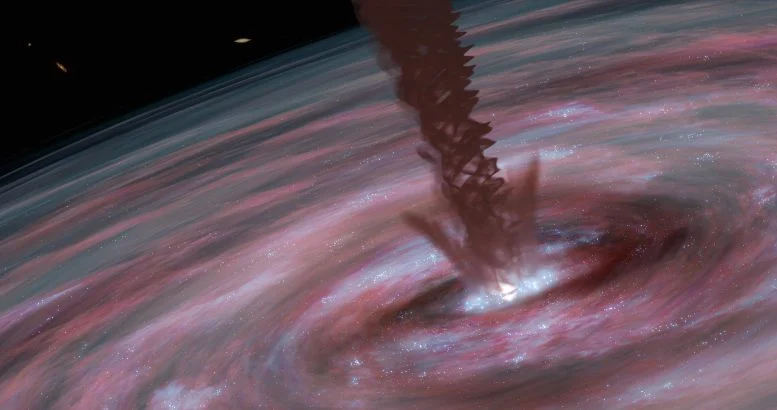
By Amanda Morris, Northwestern University July 28, 2024
Collected at: https://scitechdaily.com/magnetic-winds-drive-supermassive-black-hole-growth-in-nearby-galaxy/
Newly uncovered process is similar to how stars and planets are born.
A Northwestern University study using ALMA Observatory data revealed that rotating magnetic winds accelerate the growth of supermassive black holes, akin to star formation processes. This discovery in galaxy ESO320-G030 provides new insights into the growth mechanisms of massive cosmic entities.
By studying nearby galaxy ESO320-G030, a Northwestern University-led team of international astronomers has discovered extremely powerful rotating, magnetic winds help the galaxy’s central supermassive black hole grow.
The process is strikingly similar to the birth of new stars and planets, which are fed by swirls of gas and dust. The new discovery provides a previously unknown clue to solving the long-standing mystery of how supermassive black holes grow to weigh as much as millions or billions of stars.
“It is well-established that stars in the first stages of their evolution grow with the help of rotating winds — accelerated by magnetic fields, just like the wind in this galaxy,” said Northwestern’s Mark Gorski, who led the study. “Our observations show that supermassive black holes and tiny stars can grow by similar processes, but on very different scales.”
The study was published this spring in the journal Astronomy & Astrophysics.
An expert on the evolution of galaxies, Gorski is a postdoctoral fellow at Northwestern’s Center for Interdisciplinary and Exploratory Research in Astrophysics (CIERA). When the research began, Gorski was a postdoctoral researcher at Chalmers University of Technology in Sweden.

Colored lines with arrows show the motions of the gas traced by light from molecules of hydrogen cyanide and seen with the ALMA telescope (blue indicated motion towards us and red away). Credit: M.D. Gorski/Aaron Geller/Northwestern University/CIERA
Spying on the Milky Way’s Neighbor
Most galaxies, including our own Milky Way, have a supermassive black hole at their centers. How these mind-bogglingly massive objects grow into super sizes has remained an unsolved mystery.
In the search for clues, Gorski and his collaborators looked to relatively nearby galaxy ESO320-G030, located just 120 million light years from Earth. ESO320-G030 is a highly active galaxy, forming stars 10 times faster than the Milky Way. The astronomers examined the galaxy using telescopes at the Atacama Large Millimeter/submillimeter Array (ALMA) Observatory in Chile.
“Since this galaxy is very luminous in the infrared, telescopes can resolve striking details in its center,” said study co-author Susanne Aalto, a professor of radio astronomy at Chalmers University of Technology. “We wanted to measure light from molecules carried by winds from the galaxy’s core, hoping to trace how the winds are launched by a growing — or soon to be growing — supermassive black hole. By using ALMA, we were able to study light from behind thick layers of dust and gas.”
‘Clear Evidence of a Rotating Wind’
To examine the dense gas that closely hovers around ESO320-G030’s central black hole, the scientists studied light from hydrogen cyanide molecules. Using Doppler effect technology, the researchers imaged fine details and trace movements in the gas, which revealed patterns suggesting the presence of a magnetized, rotating wind.
While other winds and jets typically push material away from a galaxy’s central supermassive black hole, the newly discovered wind adds another process, which instead feeds the black hole and helps it grow.
The researchers liken the matter traveling around a black hole to water circling a drain. As matter approaches the black hole, it first collects in a chaotic, spinning disk. There, magnetic fields develop and grow stronger. The magnetic fields help lift matter away from the galaxy, creating a vortex of wind. As matter is lost to the wind, the spinning disk slows, which turns the slow trickle of matter into a stream — meaning that matter flows more easily into the black hole.
“We can see how the winds form a spiraling structure, billowing out from the galaxy’s center,” Aalto said. “When we measured the rotation, mass, and velocity of the material flowing outwards, we were surprised to find that we could rule out many explanations for the power of the wind, including star formation for example. Instead, the flow outwards may be powered by the inflow of gas and seems to be held together by magnetic fields.”
Future Directions in Astronomical Research
Next, the researchers plan to study the centers of other galaxies, searching for hidden spiraling outflows.
“In our observations, we see clear evidence of a rotating wind that helps regulate the growth of the galaxy’s central black hole,” Gorski said. “Now that we know what to look for, the next step is to find out how common a phenomenon this is. And if this is a stage that all galaxies with supermassive black holes go through, what happens to them next? Far from all questions about this process are answered.”
Reference: “A spectacular galactic scale magnetohydrodynamic powered wind in ESO 320-G030” by M. D. Gorski, S. Aalto, S. König, C. F. Wethers, C. Yang, S. Muller, K. Onishi, M. Sato, N. Falstad, J. G. Mangum, S. T. Linden, F. Combes, S. Martín, M. Imanishi, K. Wada, L. Barcos-Muñoz, F. Stanley, S. García-Burillo, P. P. van der Werf, A. S. Evans, C. Henkel, S. Viti, N. Harada, T. Díaz-Santos, J. S. Gallagher and E. González-Alfonso, 10 April 2024, Astronomy & Astrophysics.
DOI: 10.1051/0004-6361/202348821

Leave a Reply